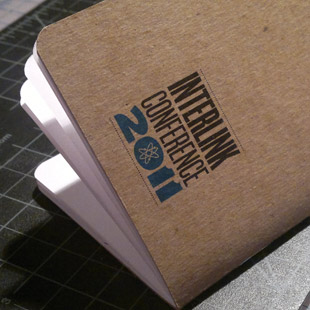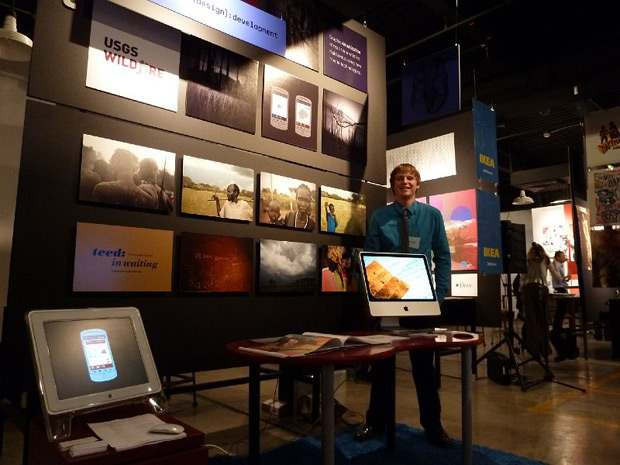 This weekend I flew up to Vancouver, BC for Interlink Conference. Normally what goes in my sketch book stays in my sketch book but I thought I’d make an exception and type out some of my notes from the main Friday sessions. I will post links to the videos as they’re released over the next couples of weeks. I hope this post can give people an idea of what was discussed and refresh the memories of those who attended. I apologize in advance to the speakers if these notes don’t encapsulate the greatness of your talks or miss any of your points.
This weekend I flew up to Vancouver, BC for Interlink Conference. Normally what goes in my sketch book stays in my sketch book but I thought I’d make an exception and type out some of my notes from the main Friday sessions. I will post links to the videos as they’re released over the next couples of weeks. I hope this post can give people an idea of what was discussed and refresh the memories of those who attended. I apologize in advance to the speakers if these notes don’t encapsulate the greatness of your talks or miss any of your points.
Frank gave one of the the best talks I’ve ever heard about the greater meaning and purpose behind what we do. He has been on a hiatus recently to re-discover meaning in his work and part of that has been the creation of his new book The Shape of Design. He shared insightful and heartfelt lessons from his time of discovery.
Near and far – these are the two sides of the design process that we alternate back and forth between. This concept can be seen more specifically in the pairs of how / why, making / thinking and execution / strategy. In web design, these often materialize as markup / structure, responsive / context, SEO / reach and Photoshop / aesthetic.
When looking at this concept in terms of time, it can be broken into three parts:
The Message: this has an infinite length.
The Format: this is the way the message is being communicated right now.
The Tone: this is the matchmaker in the middle.
Design is not problem solving because it’s “answers” aren’t repeatable (like in math). Instead, we create responses to problems.
Frank’s new word, “The Glory Form”: the best possible response from a particular person at a particular point in time.
Culture: a target that if you hit it moves.
Final thought: we are to create designs that are good, valuable and make people’s lives better.
I left Frank’s talk with a renewed excitement to be a creator of things that people see and use that have an impact on their lives. As I do my daily tasks, I need to remember to constantly step back and see how what I am doing is helping to accomplish a larger goal. I want to be conscious of defining what that larger goal (the message of infinite length) is at the beginning of the project so that I can measure it’s success, and most importantly, I want that greater goal to be something I believe makes people’s lives better.
Denise’s talk was a great way to start the day. She discussed tips on how to remain inspired in a lifestyle where our creativity in constantly being tapped out.
Externailize your inspiration – think “what does this design need to be?” instead of “I need to design this.”
Being right keeps us in place.
Inspiration and doing feed off of each other.
The premise of Elliot’s talk was “just because we can, doesn’t mean we should.” He showed numerous examples of websites following trends for the sake of following trends that just create a lot of visual noise. He then began to discuss how we address that.
Constantly asking why is how we break out of trends.
Learning how to educate clients is key for defending your decisions. Thinking about how to defend your decisions makes you make better decisions.
Perceived affordance: what makes a button look clickable.
A fluctuation between web and print design is good for staying inspired.
Recommended video: Tim Brown - “More Perfect Typography”
Whitney’s talked laid out a list of ten universal principles of UX design, showing good and bad examples of each in both the real and web world. I definitely recommend checking out her slides to supplement the list below.
UX is the establishment of a philosophy about how to treat people.
Universal experience design principles:
- Stay out of people’s way.
- Create a hierarchy that matches people’s needs.
- Limit distractions.
- Provide strong information scent.
- Provide signposts and cues.
- Provide context.
- Use constraints appropriately.
- Make actions reversible.
- Provide feedback.
- Make a good first impression.
The purpose triangle – knowledge, ethics and empathy.
What are your company’s principles?
Sarah shared resources and lessons learned from her years of experiences as a iPhone application designer, both in the native iOS format and by using web standards (this talk focused on web standards). Her slides included a lot of great tips and resources. Below are a few notes from the beginning of her talk.
ADS: Application Definitoin Statement. To make – list all features and all target users, filter through to make ADS.
Even good ideas can create scope creeps that damage good projects.
Tip for color schemes – overlay primary color 25% over all colors for a more harmonious palette.
Jonathan’s talk was entitled “CSS Takes On The World.” His Work is on the cutting edge of what’s possible with CSS. His talk listed numerous examples of common tasks done usually now with JavaScript that can start to be transitioned into CSS. Some of these include:
- Drop Down Menus (using CSS Pseudo Classes)
- FAQs (using CSS Target Pseudo Class)
- Tabs + Slides
- Form Validation
- Animations
- Better Data Tables (using display:table and flex box)
- Width Conditionals
Mentioned: jQuery Transitions + jQuery Masonry
“A Better Process”
Gavin began his talk showing a video of a German teenager bashing in his computer. We all laughed. Why? Because we’ve all been there when Photoshop crashes and we forgot to save.
He then talked about a dance we designers know all too well, “The Photoshop Shuffle,” where you spend hours moving things around only to still hate what you’ve made six hours later. Process definitely came up a lot during the day, but Gavin’s talk covered it the most. He showed photographs of his A3 sketchbook as he was working out a layout and user experience. It reminded me of the sketches I did for my PureVolume Mobile project in school and how the Photoshop work on that project came so easily after I worked everything out on paper first.
We don’t design websites, we design systems.
DELI:
Design by Decision
Design by Emotion
Design by Language
Design by Iteration
“A Dialect of Our Own Design” (slides)
Simon started out going through a brief history of our visual dialect. He used lots of examples of simple shapes in relation to one another and their frame to show how those relationships establish a visual grammar that dictates meaning and perception.
In regards to semiotics:
Symbols are specific and clear.
Icons rely on shared understanding.
Indexes link to an object but don’t depict.
What’s next for the web? The web’s frame of reference is very malleable. Simon showed examples from the fine art world of artists breaking out of the rectangular frame. He then showed examples of specific sites that are pushing the boundaries of what the frame of a web experience is.
Stop thinking in pages. Responsive (or adaptive) design is the new way of showing complex information.
Simon showed a slide of a diagram from an early Macintosh manual explaining how scrolling in the browser worked. It got me pondering that perhaps thinking about the roots of your expectations in interactions is how you can come up with ways to radically change those interactions.
The day ended with a fun night in Gastown enjoying some British Columbia micro-brews with my new-found design nerd friends. On Saturday night the Vancouver Canucks were playing in Game 2 of the Stanley Cup Finals. I met up with one of my friends from Art Center who is a Vancouver local to go watch the game at a pub downtown. The Canucks won in overtime and a 2km long party of 70,000 people in the streets erupted! Here’s a little video clip of the final goal if you missed it. It was an unforgettable end to a great weekend filled with great discussions on design and hanging out with incredible, down-to-earth and passionate people.
Update: All the talks have now been posted up on Interlink Conference’s blog.
 This weekend I flew up to Vancouver, BC for
This weekend I flew up to Vancouver, BC for 

![Teed: Portraits of [South] Sudan](https://writing.tylerpaulson.com/images/2011/teed.jpg)